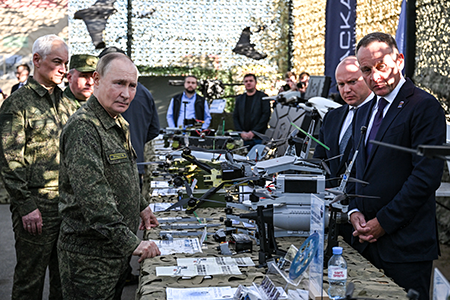"In my home there are few publications that we actually get hard copies of, but [Arms Control Today] is one and it's the only one my husband and I fight over who gets to read it first."
Belarus, Russia Practice Nuclear Operations
October 2025
By Xiaodon Liang
The Russian military in September led foreign partners in two sets of scaled-down exercises in Belarus and its own western regions, recalling larger drills that preceded the full-scale invasion of Ukraine in 2022.
Belarusian and Russian troops participated in joint drills Sept. 12-16 as part of Zapad 2025, the latest in a recurring series of quadrennial exercises.
 Large-scale Russian military exercises rotate each year across four geographical regions.
Large-scale Russian military exercises rotate each year across four geographical regions.
Although Russian President Vladimir Putin claimed 100,000 service members were involved, a Lithuanian vice minister of national defense, Tomas Godliauskas, said Aug. 14 that only 30,000 Russian and Belarussian troops were believed to be participating, according to the ELTA news agency.
Some 8,000 troops were on exercises in Belarus, of which only 2,000 were Russian, a Lithuanian intelligence official later added on Lithuanian state television. In 2022, joint exercises masking preparations for the full-scale invasion of Ukraine involved nearly 30,000 Russian troops in Belarus. (See ACT, March 2022.)
Despite the limited scale of the exercises, Polish Prime Minister Donald Tusk described Zapad 2025 as “very aggressive.” Poland held its own large-scale military exercise, named Iron Defender, in September, involving more than 30,000 troops and delegations from NATO allies, including U.S. Army personnel.
Six foreign countries sent military personnel to participate in Zapad 2025, while another 16 sent representatives to observe, the Kremlin said. An Indian contingent of 65 military personnel traveled to Russia for the exercises, TASS reported Sept. 10.
The U.S. military attaché to the embassy in Belarus–which is currently based in Lithuania–was present to observe exercises, a Pentagon spokesperson confirmed to Reuters Sept. 16, a day after the Belarusian Ministry of Defense released a video of two U.S. officers shaking hands with local counterparts on social media.
A week earlier, John Coale, a deputy to U.S. President Donald Trump’s special envoy to Russia and Ukraine, had met with Belarusian President Alexander Lukashenko to deliver a letter from Trump and to announce a deal whereby Belarus would release 52 political prisoners in exchange for the lifting of certain sanctions on its national airline, the Associated Press reported on Sept. 11.
Lukashenko confirmed Sept. 16 that his country’s forces had practiced the launch of tactical nuclear weapons with Russian counterparts as part of Zapad 2025. In a doctrinal shift in November, Russia for the first time explicitly included Belarus under its nuclear umbrella. (See ACT, December 2024.)
The Russian Ministry of Defense released a Sept. 15 video of exercises involving forces equipped with the nuclear-capable Iskander-M short-range ballistic missile system in the exclave of Kaliningrad.
Pavel Muraveiko, chief of staff of the Belarusian armed forces, said the two sides had completed exercises involving the “planning and the consideration of the application of non-strategic nuclear weapons,” and “evaluation and deployment of a mobile missile complex Oreshnik,” state media outlet BelTA reported Sept. 16.
The conventionally armed Oreshnik intermediate-range ballistic missile was first revealed by Russian forces in a Nov. 21, 2024, strike on the Ukrainian city of Dnipro. (See ACT, December 2024.)
From Aug. 31 to Sept. 6, Belarus also hosted a smaller set of military exercises under the auspices of the Collective Security Treaty Organization. Some 2,000 military personnel from Belarus, Kazakhstan, Kyrgyzstan, Russia, and Tajikistan participated, Russian news agency RIA Novosti reported Aug. 31.
